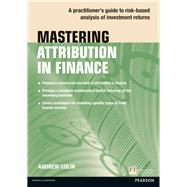Mastering Attribution in Finance is a comprehensive guide to how attribution is used in equity and fixed income markets.
Attribution in finance is a key investment and asset management process used in managed funds. A managed fund uses appropriate financial tools to make sure that the fund‘s value is maintained or increased. Attribution tools are used to analyse why a portfolio’s performance differs from a benchmark. The difference between the portfolio return and the benchmark return is known as the active return.
As with all Mastering titles, this book is written by an expert in the field. It will show you how to:
- Understand how attribution is used in equity and fixed income markets
- Improve your knowledge of the mathematics used in performance and attribution
- Assess in greater detail the effects top-down attribution and attribution on specific types of fixed income security
- Broaden your awareness of performance and return








